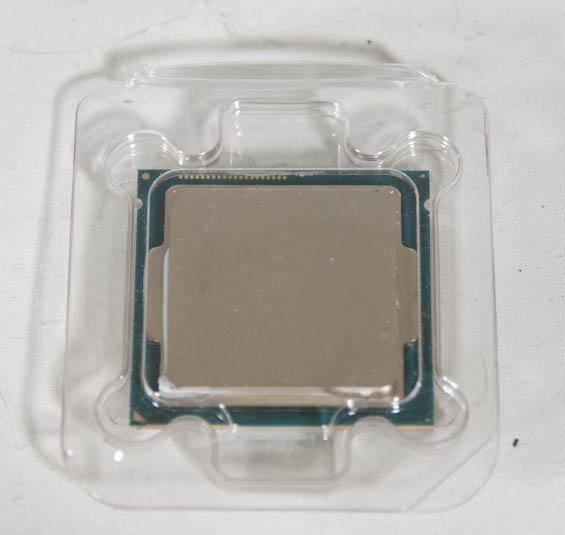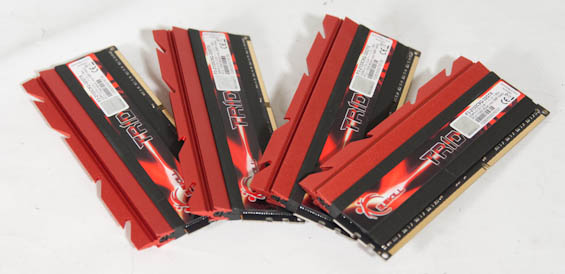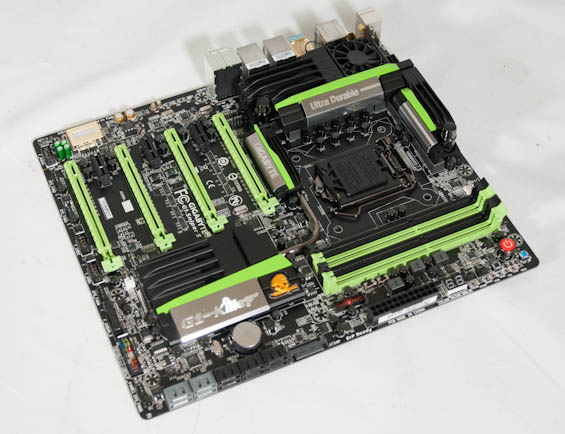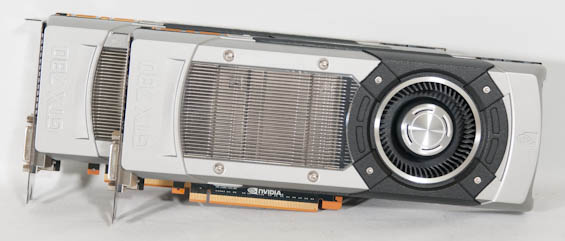The Neophyte's Custom Liquid Cooling Guide: How To, Why To, What To Expect
by Dustin Sklavos on September 30, 2013 12:01 AM ESTComponent selection for this build was tricky, but not overly so. If you're going to engage in an undertaking like this, you really do want to pick the most ideal hardware you can. Thankfully we had a few vendors willing to step up and donate some very high quality kit to this build.
Intel Core i7-4770K Processor

For our CPU we went with Intel's shiny new Haswell architecture in the form of the Core i7-4770K. This quad-core, hyper-threaded chip runs at a nominal 3.5GHz clock with a maximum turbo boost of 3.9GHz on a single core, and is one of Intel's first chips to feature an integrated VRM. Intel's 22nm chips seem to have been largely thermally limited, making the newest member of the family a compelling choice to be the center of a watercooling build. You do always run the risk of getting a dud CPU that simply doesn't want to run at a high clock speed without an unrealistic amount of voltage, though. Note that ours is a retail chip and not an Engineering Sample, so it's subject to the same potential limitations as any CPU you might pick up off the shelf.
Our thanks to CyberPowerPC for graciously donating this processor.
G.Skill Trident X 32GB (4x8GB) DDR3-2133 RAM

Our resident motherboard reviewer and overclocking expert, the good Dr. Ian Cutress, recommended we go with G.Skill for this build, and G.Skill was happy to oblige with a respectable kit of fast DDR3. This kit runs at a nominal 1600MHz, but features an XMP profile that sets it to run at 2133MHz with a CAS Latency of 9 at 1.6V. I'm not an aggressive memory overclocker, which makes the ready-out-of-the-box 2133MHz settings an easy way to score a little extra performance.
Our thanks to G.Skill for providing this memory.
Gigabyte G1.Sniper 5 Z87 Motherboard

I remain of the opinion that the Z87 chipset is arguably the most compelling part of Haswell, and Gigabyte's high end gaming offering hammers that home. The G1.Sniper 5 features a PLX switch enabling full PCIe 3.0 x16 lanes for each of two video cards, or PCIe 3.0 x8 for up to four. Alongside that are an additional four SATA 6Gbps ports to go along with the six that come with the Z87 chipset, dual gigabit ethernet NICs with one provided by Intel and the other courtesy of Killer Networks, and Creative Sound Core3D with a user upgradeable OP-AMP. There's even an 802.11n dual-band PCIe x1 wireless network adapter bundled with the motherboard.
But what sells this board for our purposes is that it includes not only active cooling on the motherboard's 16-phase power circuitry, but a liquid cooling path built in. There are barbs on both ends of the heatsink that allow you to include the power circuitry in your watercooling loop.
Our thanks to Gigabyte for providing this motherboard.
Dual NVIDIA GeForce GTX 780 Graphics Cards

With AMD currently still having issues with multi-GPU surround performance, we were left going to NVIDIA for a pair of high end graphics cards. Two GeForce GTX 770s would've been stellar on their own, but the 780 is getting a healthy reputation as being a decent overclocker in addition to just being a tremendously powerful card on its own. 7.1 billion transistors and 2,304 CUDA cores are nothing to sneeze at, and the 384-bit memory bus connected to 3GB of GDDR5 running at 6GHz stock ensures that beefy engine stays fed.
The biggest shame about using these reference 780s is actually having to remove their stock coolers. NVIDIA did a fantastic job engineering these shrouds, which are both very beautiful and very efficient.
Our thanks to NVIDIA for providing this pair of graphics cards.










106 Comments
View All Comments
madisoncarter127 - Monday, September 30, 2013 - link
himadisoncarter127 - Monday, September 30, 2013 - link
My last pay check was $11000working 10 hours a week online. My brothers friend has been averaging 17k for months now and she works about 18 hours a week. I can't believe how easy it was once I tried it out.dgingeri - Monday, September 30, 2013 - link
You've sold me on the case, and convinced me to not try water cooling for a while longer, and possibly never. It looks like a lot of hard work for little to no reward. I'll stick to my H100. The case looks great, though.Shinobi_III - Monday, September 30, 2013 - link
If you put the pump in a reservoir, you will no longer have a "noisy" pump.Noisy being a rather absurd wording, considering how incredibly little noise a EHEIM 600l/h pump produces.
That pump you used in the article is ridiculous, what is that, a pump for ants?
And compression fittings are complete suicide, they fail sooner or later.
Perfectly regular ridged slide-over fittings, and a zip tie if you're nervous, will never fail.
And the coolant is ridiculous too, get "long life" automotive coolant, mix it 1:10 and you will never need to worry again. Those bottles are just rebranded, ready-mixed glycol with a giant price tag.
HisDivineOrder - Monday, September 30, 2013 - link
Watercooling GPU's makes sense, but how long before CLC is common on those? It can't be long since everyone's used to CLC's on CPU's where you don't even need water cooling at all. I imagine it won't be long before GPU's too don't need watercooling anymore since they'll be integrated into the CPU.Given that Intel will make its own version of Mantle in short order that they'll pay entire publishers to use, I'm pretty sure we can kiss any advantage discrete cards have goodbye. I'm sure Intel will send AMD a fruit basket for both the idea and making everyone okay with it.
ImSpartacus - Monday, September 30, 2013 - link
Hot damn, this is comprehensive as fuck.Good article!
livingplasma - Monday, September 30, 2013 - link
Thanks for the great article, it's good to see a major tech site like Anandtech cover the often misunderstood art of water cooling. Just skimmed through the comments and a lot of my fellow water cooling guys/gals made some very important points. From my experience it is most important for radiator fan orientation to act as INTAKES. Flipping those top fans to intake can decrease your load temps ~8 degrees celcius from my experience as the way it's currently set up the top 2x120 radiator is using the air from the 3x120 radiator (which is already saturated with heat). Properly decoupled pumps will minimize noise/vibration transmission to the case and with the MCP35X's PMW control it can run very quietly when slowed down 50% which is more than enough flow for most setups. Radiators themselves are low flow resistance, full cover gpu blocks are probably next and CPU blocks tend to have the most but even maxing out a pump only decreases temperatures CPU by a degree or two (plus now the pump is dumping in more heat as well). Removing the stock GPU cooling setups is probably the biggest contributions to water cooling being more quiet than a regular air setup and even with a modest setup the temperature differences are huge as shown with the author's setup.1Angelreloaded - Monday, September 30, 2013 - link
Dustin, Do you know the difference between a Serial and Parallel loop? or how the High flow and Low Flow pressures effect heat dissipation on certain blocks? I understand this may be your first time setting this up; however, in the computer field research is everything, you already know this just like modifying a car without research you end up with an underperforming and underwhelming creation. This is not how a liquid cooled setup should be set up at all, and BTW your Proc temps are higher because the Air source feeding it is already heated from your GPU Rad outlet, try reversing the flow on intake to exit Flow and your CPU temps will be better, CPUs on average run at lower temps on full loads compared to GPUs that can average 70-80 C especially while gaming.hot120 - Tuesday, October 1, 2013 - link
Man, there are quite a few fake 'experts' critiquing this fine article. It seems everyone wants the article done their way. Delid this CPU, change that fan, move this radiator, use that Kill Coil. Enough is enough. It is a basic article on watercolling, and is not meant to cover EVERY SINGLE POSSIBLE configuration. Only the most extreme of the extreme computer users will consider delidding their CPU's. Only the most insane of the extreme computer users will spend $800 on a custom loop to shave 5-10 degrees off their CPU/GPU temps. I'll take my $100 and by a CLC and live happily ever after with my CPU that is +10 degrees (over custom) and my air-cooled GPU. Some of you are tripping!pandemonium - Tuesday, October 1, 2013 - link
Thanks for the introduction article to watercooling. To me - verified according to the results - this says it's still not worth it for a general user and gamer. The cost of increased power, thermals, and noise do not appear to outweigh the performance increase. I know other setups produce better results, but this is a good sample for not bothering with it.Watercooling is still for benchmarking...and that's about it.